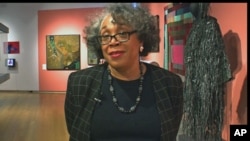Works by more than 100 African, African-descended, or simply African-influenced artists from around the world are the focus of a new show at New York's Museum of Arts and Design.
"The Global Africa Project" is the first Africa-centered show at the museum, which specializes in the arts of craftsmanship and design. Among the African nations represented are Nigeria, Kenya, South Africa, Malawi, Senegal, Togo, Cameroon, Uganda, Ghana, Botswana, Mali, Ivory Coast, Madagascar, Mozambique, the Comoros and Algeria. Many of the pieces on display, though, were created outside of Africa.
That's because many African and African-descended - or simply African-influenced - artists and designers today are as likely to live and work at least part-time in Europe, the Americas, or even Asia. As co-curator Lowery Stokes Sims noted, the show includes natives and residents of the United States, Great Britain, France, Germany, Italy, Haiti, Barbados, Cuba and Trinidad - and even one or two from Japan.
Traditional mosaic-like quilts from Karnatka, India, on display are made by Indian women descended from early African immigrants and former slaves in Goa who formed the Siddi Women's Quilting Cooperative.
Quilts in another patchwork style are the work of American descendants of slaves, the Gee's Bend Quilters collective in the southern U.S. state of Alabama.
Besides textiles, the exhibit presents works in media ranging from architecture, basketry and photography, to furniture, ceramics, fashion, metalwork and jewelry. Some of the pieces touch explicitly on such topics as racial identities, environmental damage from the oil industry, AIDS and the end of apartheid. Others, like the baskets made by Gahaya, a collective of Hutu and Tutsi women in Rwanda, are tangible symbols of their makers' hopes.
Most objects in the show, however, seem intended simply to be beautiful, or arresting. Sims said the show's variety demonstrates the impossibility of defining a particular "African" sensibility.
"We would be hard-put to say, is it a certain use of color, a certain use of form," Sims said, "because the creators come from such diverse experiences and backgrounds that you really couldn't. I think that if a person comes and thinks they know what this exhibition is about and then they go away, and realize they don't know what this exhibition is about, and they're confused - that's exactly where we want them to be."
The profusion of styles and interests spilling out over three floors of the Museum of Arts and Design is indeed head-spinning. Still, there are kindred works. A traditional New Orleans "Indian" carnival costume of white feathers is entirely at home with a shaman-like figure created by a Malian artists' collective. Either could dance with one of American artist Nick Cave's towering, colorful "sound suits."
Despite the variety of their work and backgrounds, Sims said, the show's artists did share one response in common.
"I've been struck time and time again," she said, "by how the artists said to me that this exhibition is so important for countering all the negative images we have of Africa: of war, genocide, struggle over resources, AIDS, et cetera."
Visitors on a recent day were enthusiastic. "I like the variety and just the richness of the experience they are conveying to us," said one woman. "It's incredible. It kind of just overpowers you - it's beautiful," said another.
The New York Times art critic Roberta Smith agreed, calling the show "astoundingly ambitious," though she said it suffered from too many "high-end luxury" pieces and a lack of life-changing design solutions.
But Sims noted that the Museum of Arts and Design always focuses primarily on the aesthetics of craft and design. The show, co-curated by Leslie King-Hammond of the Maryland Institute College of Art, will be at the Museum of Arts and Design through May 15, 2011.








